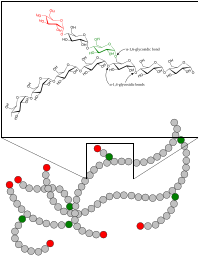Glycogen Storage Disease Vi

A number sign (#) is used with this entry because glycogen storage disease VI (GSD6) is caused by homozygous or compound heterozygous mutation in the PYGL gene (613741), which encodes liver glycogen phosphorylase, on chromosome 14.
Clinical FeaturesThe clinical picture in glycogen storage disease VI is one of mild to moderate hypoglycemia, mild ketosis, growth retardation, and prominent hepatomegaly. Heart and skeletal muscle are not affected. The prognosis seems to be excellent (Hers, 1959; Hers and van Hoof, 1968).
Wallis et al. (1966) determined erythrocyte glycogen concentration and leukocyte phosphorylase activity in 17 members of 4 generations of the family of a boy with biopsy-proved glycogen storage disease type VI.
Chang et al. (1998) studied a Mennonite family in which the diagnosis of glycogen storage disease type VI had first been made in a 22-month-old girl in 1962. The patient had hepatomegaly, fatigue, and decelerating linear growth. Liver and muscle biopsies showed enlarged hepatocytes with a granular substance consistent with glycogen. Muscle glycogen was normal but liver glycogen was 20%, approximately 4 times the control values. Seventeen individuals with glycogen storage disease were studied. Pedigree analysis showed that all families could be traced back to a couple who lived in eastern Pennsylvania in the 1830s. One instance of pseudodominance was observed; an affected mother married to a distant cousin had an affected son.
Roscher et al. (2014) reported on 21 patients (17 males and 4 females) from 17 unrelated families with glycogen storage disease (GSD) IXa (306000), GSD IXb (261750), GSD IXc (613027), or GSD VI, which are caused by phosphorylation deficiencies. The average age was 11.66 years, with a range of 3 to 18 years. Eleven patients (53%) had GSD IXa1; 3 (14%) had GSD IXb; 3 (14%) had GSD IXc; and 4 (19%) had GSD VI. The average age of initial presentation was 20 months (range 4-160 months). The GSD IXb patients presented earliest at the age of 5 months (range 4-6 months). Hepatomegaly was present in 95% of patients on physical examination and 100% on liver ultrasound. Four patients presented with failure to thrive, and 2 with short stature. None of the patients had intellectual disability or global developmental delay at most recent evaluation, although some had early developmental delay. Alanine transaminase (ALT) was elevated in 18 patients (86%), and aspartate transaminase (AST) was elevated in 19 (90%). Hypercholesterolemia was present in 14 of the 21 patients, and hypertriglyceridemia was present in 16. While previous reports noted hypoglycemia in 17 to 44% of patients with GSD VI or subtypes of GSD IX, hypoglycemia occurred in less than 5% of the patients in the cohort of Roscher et al. (2014). Two patients had developed likely liver adenomas at long-term follow-up, which had not been theretofore reported.
MappingIn a Mennonite family segregating glycogen storage disease VI, Chang et al. (1998) found linkage of the disorder to the PYGL locus on chromosome 14, with a multipoint lod score of 4.7.
InheritanceGlycogen storage disease VI is an autosomal recessive disorder (Burwinkel et al., 1998; Chang et al., 1998).
Molecular GeneticsIn 3 patients with Hers disease, Burwinkel et al. (1998) identified mutations in the PYGL gene in homozygous or compound heterozygous state (613741.0001-613741.0004).
By sequencing genomic DNA in a Mennonite family segregating glycogen storage disease VI, Chang et al. (1998) identified a homozygous abnormality of the intron 13 splice donor (613741.0005). This mutation was estimated to be present on 3% of Mennonite chromosomes and the frequency of the disease was estimated to be 1 in 1,000 in that population. Determination of the mutation provided a basis for the development of a simple and noninvasive diagnostic test for the disease and the carrier state in this population.
HistoryHers and Van Hoof (1968) suggested that glycogen storage disease type VI was a 'waiting room' from which new entities will be separated in the future; type VI was later reserved for cases with liver phosphorylase deficiency as the primary defect.
There is confusion in the numbering system of the glycogen storage diseases: hepatic phosphorylase deficiency, here designated GSD VI, was labeled GSD VIII in Stanbury et al. (1983).